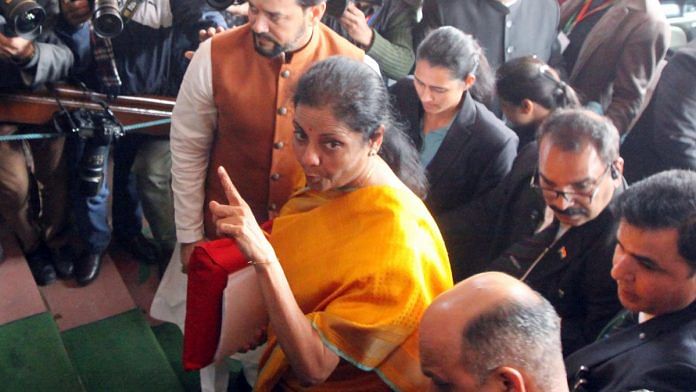New Delhi: India’s fiscal deficit will be as high as 4.6 per cent in 2019-20 and 4.4 per cent in 2020-21 if one includes the various off-budget borrowings of the government that have to be directly serviced from the Consolidated Fund of India.
The government has once again opted to go for the off-budget financing route to meet some of its liabilities and rein in its fiscal deficit numbers, including shifting the food subsidy burden out of the budget by forcing the Food Corporation of India (FCI) to borrow from the National Small Savings Fund (NSSF).
The total off-budget borrowings will be in excess of Rs 2.35 lakh crore in 2020-21, as against a revised Rs 2.17 lakh crore in the 2019-20 budget, according to the annexure to Finance Minister Nirmala Sitharaman’s budget speech.
These numbers include borrowings from the NSSF by entities like the FCI and Building Materials and Technology Promotion Council, and fully serviced bonds used to raise funds for some of the government’s welfare and development schemes.
Also read: LIC to tax charter: Budget 2020 wants India in the big league, but offers mere quick fixes
Food subsidy burden not fully accounted for
Food subsidy has been reduced to Rs 1.08 lakh crore in the revised estimates for 2019-20 from the initially estimated Rs 1.84 lakh crore. The food subsidy for 2020-21 has been budgeted at Rs 1.15 lakh crore.
At the same time, the FCI, the agency administering the National Food Security Act, is budgeted to borrow Rs 1.1 lakh crore from the NSSF in 2019-20, and Rs 1.36 lakh crore in 2020-21.
This would take the total dues of the FCI from the NSSF in 2020-21 to Rs 3.91 lakh crore, if one excludes the scheduled repayment of Rs 68,400 crore due in that year.
The government resorted to using the NSSF route to fund the food subsidy from the year 2016-17 to reduce the fiscal burden, and has continued the practice ever since.
Fully serviced bonds, or those raised for government schemes and fully serviced by the government, will also increase to Rs 49,500 crore in 2020-21 from Rs 44,584 crore in 2019-20, in order to fund schemes like the Saubhagya scheme and the Jal Jeevan Mission.
Also read: No big fiscal stimulus in Nirmala Sitharaman’s Budget 2020, but govt can still do it later
Fiscal deficit revision
Even without accounting for these off-budget liabilities, the government significantly revised the fiscal deficit target to 3.8 per cent in 2019-20 from 3.3 per cent, and to 3.5 per cent in 2020-21 from 3 per cent.
Subhash Chandra Garg, former finance secretary, said the government could have used the opportunity to make off-budget borrowings part of the budget.
“The government should have amended the Fiscal Responsibility and Budget Management Act and set a new glide path,” Garg said, adding that the government’s justification of the deviation from the fiscal deficit target is not correct.
In her budget speech, Sitharaman quoted Section 4 (2) of the FRBM Act that provides for a trigger mechanism for a deviation from the estimated fiscal deficit on account of structural reforms in the economy with unanticipated fiscal implications to justify the 0.5 per cent deviation from the fiscal glide path for 2019-20 and 2020-21.
The medium term fiscal policy framework put out as part of the budget points out that correct representation of central government debt is the starting point for debt management and control. However, it adds that this cannot entail inclusion of all liabilities of all central public sector enterprises/autonomous bodies as part of government borrowings, since most such borrowings are done for the purpose of their routine business activity.
Also read: Sitharaman cuts budget for Modi’s pet Ayushman Bharat scheme over fund ‘under-utilisation’







1. This is an interesting article. My view is that most ordinary citizens won’t understand anything about fiscal deficit and other terms used in this article. 2. My simple suggestion is that all governments follow commercial system of accounting which just needs maintaining record of all transactions of expenditure and income on accrual basis. Once this is done, the so-called difficulty in arriving at figure of fiscal deficit can be considerably lessened. 3. We are aware of fact that listed companies follow and implement provisions in the Companies Act and also SEBI’s guidelines to regarding disclosure of important financial information in specific formats. If both Central and all State governments strictly follow commercial system of accounting, as mentioned earlier, and accordingly prepare statements of financial performance in proper formats, there won’t be any secrecy around fiscal deficit figures.